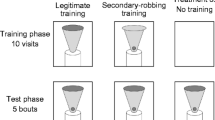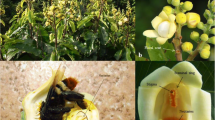Summary
By experimental manipulation of the nectar in flowers, I characterized the decision-making process used by nectar-gathering bumblebees for initiating movements between inflorescences of wild bergamot. The decision-making process has these characteristics: departure from an inflorescence is less likely as nectar rewards increase; departure decisions are based on the amount of nectar in the last flower probed and are not influenced by the nectar rewards in either the previously probed flower or the previously visited inflorescence; the number of flowers already probed at an inflorescence influences departure decisions weakly; a bees' response (to stay or to depart) to a given size of nectar reward is variable. Since previously proposed foraging rules do not accord with this description, I propose a new rule. I show by experiment that the movements made by bumblebees enhance foraging success.
Similar content being viewed by others
References
Bovet P (1985) The adaptive fitness of randomness in choice and foraging behavior. Beh Brain Sci 8:315–330
Cameron SA (1981) Chemical signals in bumblebee foraging. Beh Ecol Sociobiol 9:257–260
Charnov EL (1976) Optimal foraging: the marginal value theorem. Theor Pop Biol 9:129–136
Cheverton J (1982) Bumblebees may use a suboptimal arbitrary handedness to solve complex foraging decisions. Anim Beh 30:934–935
Cibula DA, Zimmerman M (1986) The effect of plant density on departure decisions: testing the marginal value theorem using bumblebees and Delphinium nelsonii. Oikos 43:154–158
Cowie RJ (1977) Optimal foraging in great tits (Parus major). Nature 268:137–138
Cresswell JE (1989) Optimal foraging theory applied to bumblebees gathering nectar from wild bergamot. Ph.D. thesis, University of Michigan, MI, USA
Cruden RW, Hermanutz L, Shuttleworth J (1984) The pollination biology and breeding system of Monarda fistulosa (Labiatae). Oecologia 64:104–110
Emlen JM (1966) The role of time and energy in food preference. Am Nat 100:611–617
Galen C, Plowright RC (1985) The effects of nectar level and flower development on pollen carry-over in inflorescences of fireweed (Epilobium angustifolium) (Onagraceae). Can J Bot 63:488–491
Green RF (1980) Bayesian birds: a simple example of Oaten's stochastic model of optimal foraging. Theor Pop Biol 18:244–256
Hartling LK, Plowright RC (1978) Foraging by bumble bees on patches of artificial flowers: a laboratory study. Can J Zool 57:1866–1870
Hodges CM (1981) Optimal foraging in bumblebees: hunting by expectation. Beh Ecol Sociobiol 9:41–44
Hodges CM (1985a) Bumble bee foraging: the threshold departure rule. Ecology 66:179–187
Hodges CM (1985b) Bumble bee foraging: energetic consequences of using a threshold departure rule. Ecology 66:188–197
Iwasa I, Higashi M, Yamamura N (1981) Prey distribution as a factor determining the choice of optimal foraging strategy. Am Nat 117:710–723
Janetos AC, Cole BJ (1981) Imperfectly optimal animals. Beh Ecol Sociobiol 9:203–209
Kato M (1988) Bumblebee visits to Impatiens spp: pattern and efficiency. Oecologia 76:364–370
Krebs JR, Ryan JC, Charnov EL (1974) Hunting by expectation or optimal foraging? A study of patch use by chickadees. Anim Behav 22:953–964
Lima SL (1984) Downy woodpecker foraging behavior: efficient sampling in simple stochastic environments. Ecology 65:166–174
Lima SL (1985) Sampling behavior of starlings foraging in simple patchy environments. Beh Ecol Sociobiol 16:135–142
MacArthur RH, Pianka ER (1966) On optimal use of a patchy environment. Am Nat 100:603–609
Marden JH (1984) Remote perception of floral nectar by bumblebees. Oecologia 64:232–240
Maynard-Smith J (1978) Optimization theory in evolution. Ann Rev Ecol Syst 9:31–56
Mazur JE (1983) Reply to staddon and Hinson. Science 221:977
McKenna MA, Thomson JD (1988) A technique for sampling and measuring small amounts of floral nectar. Ecology 69:1306–1307
McNair JN (1985) Optimal foraging for operant conditioners. Beh Brain Sci 8:343–344
McNamara J, Houston A (1980) The application of statistical decision theory to animal behavior. J Theor Biol 85:673–690
Ollason JG (1980) Learning to forage- optimally? Theor Pop Biol 18:44–56
Pleasants JD (1983) Nectar production patterns in Ipomopsis aggregata (Polemoniaceae). Am J Bot 70:1468–1475
Pyke GH (1979) Optimal foraging in bumblebees: rule of departure between flowers within inflorescences. Anim Beh 27:1167–1181
Pyke GH (1982) Foraging in bumblebees: rule of departure from an inflorescence. Can J Zool 60:417–428
Real L, Caraco T (1986) Risk and foraging in stochastic environments. Ann Rev Ecol Syst 17:371–390
Real L, Rathcke BJ (1988) Patterns of individual variability in floral resources. Ecology 69:728–735
Schoener TW (1971) Theory of feeding strategies. Ann Rev Ecol Syst 2:369–404
sokal RR, Rohlf FJ (1981) Biometry (2nd ed.) W.H. Freeman and Co., NY, USA
Staddon JER, Hinson JM (1983) Optimization: a result or a mechanism? Science 221:976–977
Stephens DW, Krebs JR (1986) Foraging Theory. Princeton University Press, NJ, USA
Thomson JD, Maddison WP, Plowright RC (1982) Behavior of bumbleebee pollinators of Aralia hispida Vent. (Araliaceae). Oecologia 54:326–336
Waddington KD (1981) Factors influencing pollen flow in bumblebee-pollinated Delphiniun virescens. Oikos 37:153–159
Zimmerman M (1983) Plant reproduction and optimal foraging: experimental nectar manipulations in Delphinium nelsonii. Oikos 41:57–63
Zimmerman M, Pyke GH (1986) Reproduction in Polemonium: patterns and implications of floral nectar production and standing crops. Am J Bot 73:1405–1415
Author information
Authors and Affiliations
Rights and permissions
About this article
Cite this article
Cresswell, J.E. How and why do nectar-foraging bumblebees initiate movements between inflorescences of wild bergamot Monarda fistulosa (Lamiaceae)?. Oecologia 82, 450–460 (1990). https://doi.org/10.1007/BF00319785
Received:
Accepted:
Issue Date:
DOI: https://doi.org/10.1007/BF00319785




